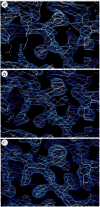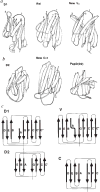Crystal structure of an HIV-binding recombinant fragment of human CD4
- PMID: 2247146
- PMCID: PMC5638305
- DOI: 10.1038/348419a0
Crystal structure of an HIV-binding recombinant fragment of human CD4
Abstract
CD4 glycoprotein on the surface of T cells helps in the immune response and is the receptor for HIV infection. The structure of a soluble fragment of CD4 determined at 2.3 A resolution reveals that the molecule has two intimately associated immunoglobulin-like domains. Residues implicated in HIV recognition by analysis of mutants and antibody binding are salient features in domain D1. Domain D2 is distinguished by a variation on the beta-strand topologies of antibody domains and by an intra-sheet disulphide bridge.
Figures





Comment in
-
Immunology. One hand clapping.Nature. 1990 Nov 29;348(6300):393-4. doi: 10.1038/348393a0. Nature. 1990. PMID: 2247144 No abstract available.
Similar articles
-
Atomic structure of a fragment of human CD4 containing two immunoglobulin-like domains.Nature. 1990 Nov 29;348(6300):411-8. doi: 10.1038/348411a0. Nature. 1990. PMID: 1701030
-
Identification and structural analysis of residues in the V1 region of CD4 involved in interaction with human immunodeficiency virus envelope glycoprotein gp120 and class II major histocompatibility complex molecules.Proc Natl Acad Sci U S A. 1990 Nov;87(22):9052-6. doi: 10.1073/pnas.87.22.9052. Proc Natl Acad Sci U S A. 1990. PMID: 1978941 Free PMC article.
-
Mutational analysis of the interaction between CD4 and class II MHC: class II antigens contact CD4 on a surface opposite the gp120-binding site.Cell. 1991 Sep 6;66(5):1037-49. doi: 10.1016/0092-8674(91)90447-7. Cell. 1991. PMID: 1889086
-
Structure and interactions of CD4.Cold Spring Harb Symp Quant Biol. 1992;57:541-8. doi: 10.1101/sqb.1992.057.01.059. Cold Spring Harb Symp Quant Biol. 1992. PMID: 1339691 Review. No abstract available.
-
Structure-based design, synthesis and validation of CD4-mimetic small molecule inhibitors of HIV-1 entry: conversion of a viral entry agonist to an antagonist.Acc Chem Res. 2014 Apr 15;47(4):1228-37. doi: 10.1021/ar4002735. Epub 2014 Feb 6. Acc Chem Res. 2014. PMID: 24502450 Free PMC article. Review.
Cited by
-
CD4 peptide-protein conjugates, but not recombinant human CD4, bind to recombinant gp120 from the human immunodeficiency virus in the presence of serum from AIDS patients.Proc Natl Acad Sci U S A. 1991 Jul 1;88(13):5690-3. doi: 10.1073/pnas.88.13.5690. Proc Natl Acad Sci U S A. 1991. PMID: 2062847 Free PMC article.
-
Facing the phase problem.IUCrJ. 2023 Sep 1;10(Pt 5):521-543. doi: 10.1107/S2052252523006449. IUCrJ. 2023. PMID: 37668214 Free PMC article.
-
Identification of CD4 and major histocompatibility complex functional peptide sites and their homology with oligopeptides from human immunodeficiency virus type 1 glycoprotein gp120: role in AIDS pathogenesis.Proc Natl Acad Sci U S A. 1993 Aug 15;90(16):7573-7. doi: 10.1073/pnas.90.16.7573. Proc Natl Acad Sci U S A. 1993. PMID: 8356059 Free PMC article.
-
Determinants of human immunodeficiency virus type 1 entry in the CDR2 loop of the CD4 glycoprotein.J Virol. 1995 Jan;69(1):166-71. doi: 10.1128/JVI.69.1.166-171.1995. J Virol. 1995. PMID: 7983707 Free PMC article.
-
The cytoplasmic domain of CD4 plays a critical role during the early stages of HIV infection in T-cells.EMBO J. 1994 Dec 1;13(23):5559-69. doi: 10.1002/j.1460-2075.1994.tb06893.x. EMBO J. 1994. PMID: 7988553 Free PMC article.
References
Publication types
MeSH terms
Substances
Grants and funding
LinkOut - more resources
Full Text Sources
Other Literature Sources
Molecular Biology Databases
Research Materials

